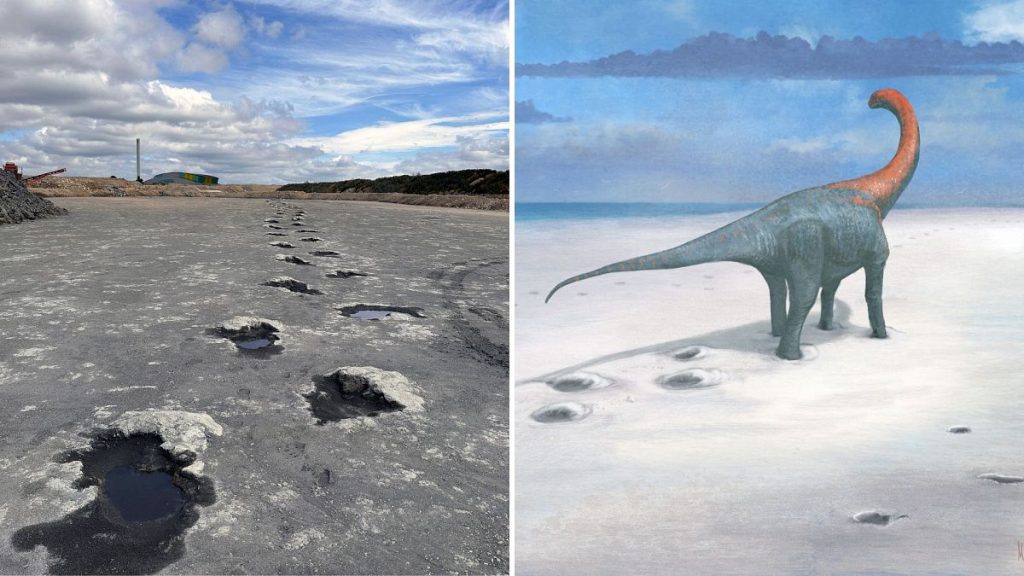A Jurassic Highway Uncovered: Oxfordshire Quarry Reveals UK’s Largest Dinosaur Trackway
The rolling hills of Oxfordshire, England, have yielded an extraordinary treasure – the UK’s largest dinosaur trackway, a remarkable window into the Jurassic period. Unearthed at Dewars Farm Quarry, this sprawling site boasts hundreds of footprints, imprinted in the earth some 166 million years ago. The discovery, a collaborative effort between the Universities of Oxford and Birmingham, paints a vivid picture of a prehistoric landscape teeming with both gigantic herbivores and fearsome predators, their paths intersecting on this ancient "dinosaur highway." The sheer scale of the site, combined with the presence of megalosaurus tracks – a species historically linked to Oxfordshire – makes this a doubly significant find, especially as it coincides with the 200th anniversary of the dinosaur’s scientific naming.
Spanning an impressive area, the quarry reveals five major trackways, the longest stretching over 150 meters. These fossilized pathways offer a unique form of evidence, capturing a specific moment in time. Unlike fossilized bones which can be displaced over time, footprints remain anchored to their original location, providing invaluable insights into the creatures that made them. Four of the trackways bear the distinctive prints of sauropods, massive long-necked herbivores, including cetiosaurus, which could reach lengths of up to 18 meters. These giants, lumbering across the landscape, left behind deep impressions, testament to their immense size and weight. The fifth trackway, however, tells a different story – the tale of a predator. Here, the three-toed, clawed prints of megalosaurus, a nine-meter-long carnivorous theropod, are etched into the stone, a chilling reminder of the dangers that lurked in this prehistoric world.
The discovery of these tracks began with a keen observation. Gary Johnson, a quarry worker, noticed unusual markings in the clay and alerted researchers, setting in motion a chain of events that would culminate in a major paleontological find. Over a week-long period, a dedicated team of over 100 scientists, volunteers, and quarry staff worked tirelessly to uncover the treasure trove of over 200 footprints. Employing cutting-edge technology, the team utilized aerial drones to capture 20,000 images, which were then used to create detailed 3D models of the site. This digital preservation ensures that the trackway will be accessible to researchers and the public for generations to come, providing an enduring record of this remarkable discovery.
Professor Kirsty Edgar, a micro-palaeontologist from the University of Birmingham, emphasizes the significance of the find on two fronts. Firstly, the sheer size of the site sets it apart. While the UK boasts several coastal dinosaur track sites, they are typically small. The Dewars Farm Quarry site, however, is immense, dwarfing other known UK trackways and ranking among the largest globally. This vast expanse offers a wealth of information, providing a more comprehensive understanding of the dinosaur populations that inhabited the area during the Middle Jurassic. The range of species represented, the sheer number of footprints, and the length of the trackways provide an unparalleled opportunity to study dinosaur behavior, locomotion, and interactions.
The second aspect that makes this discovery particularly significant is its connection to the history of dinosaur paleontology. 2024 marked the 200th anniversary of the scientific naming of dinosaurs, with megalosaurus holding the distinction of being the first dinosaur ever officially named and described, back in 1824. Remarkably, the original megalosaurus fossil was discovered in Oxfordshire, making the discovery of megalosaurus tracks in the Dewars Farm Quarry, in the same county, a poignant and fitting tribute. This serendipitous connection adds another layer of historical significance to the find, linking the present discovery to the very beginnings of dinosaur research.
The impressive trackway find will take center stage in a new exhibition titled "Breaking Ground" at the Oxford University Museum of Natural History (OUMNH). The exhibition, running until 29 September 2025, promises to offer visitors an up-close look at this remarkable piece of Jurassic history. The footprints, preserved for millions of years, offer a tangible connection to a time when giants roamed the Earth. They provide not just a glimpse into the lives of individual dinosaurs, but also a richer understanding of the Jurassic ecosystem, the interactions between predator and prey, and the environment in which they lived. The Dewars Farm Quarry discovery stands as a testament to the power of observation, the importance of collaboration, and the enduring fascination with these prehistoric behemoths. The "dinosaur highway" has been rediscovered, offering a pathway to a deeper understanding of our planet’s ancient past.














